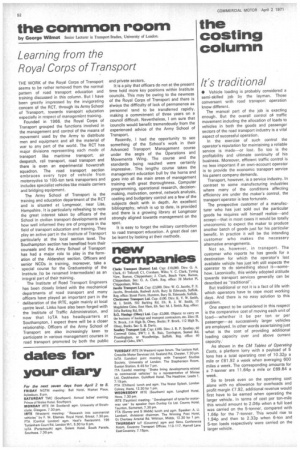the common room
Page 54

If you've noticed an error in this article please click here to report it so we can fix it.
by George Wilmot Senior Lecturer in Transport Studios, University of London.
Learning from the Royal Corps of Transport
THE WORK of the Royal Corps of Transport Seems to be rather removed from the normal pattern of road transport education and training discussed in this column. But I have been greatly impressed by the invigorating concern of the RCT, through its Army School of Transport, towards transport education especially in respect of management training.
Founded in 1966, the Royal Corps of Transport grouped the functions involved in the management and control of the means of movement used by the Army to distribute men and equipment and all the material of war to any part of the world. The RCT has major divisions representing each mode of transport like maritime transport, air despatch, rail transport, road transport and there is even an experimental hovercraft squadron. The road transport section embraces every type of vehicle from motorcycles to 100-ton tank transporters and includes specialist vehicles like missile carriers and bridging equipment.
The Army School of Transport is the training and education department of the RCT and is situated at Longmoor, near Liss, Hampshire. It is particularly refreshing to note the great interest taken by officers of the School in civilian transport developments and how well informed they are of progress in the field of transport education and training. They play an active part in the Institute of Transport particularly at the local section level. The Southampton section has benefited from their counsels and the Army School of Transport has had a major role to play in the formation of the Aldershot section. Officers and senior NCOs in training, moreover, take a special course for the Graduateship of the Institute (to be renamed Intermediate) as an integral part of their training.
The Institute of Road Transport Engineers has been closely linked with the mechanical departments of road transport and many officers have played an important part in the deliberation of the IRTE, again mainly at local centre level. Links have also been forged with the Institute of Traffic Administration, and now that loTA has headquarters at Southampton, I expect there will be a closer relationship. Officers of the Army School of Transport are also increasingly keen to participate in various management courses in road transport promoted by both the public and private sectors.
It is a pity that officers do not at the present time hold more key positions within Institute councils. This may be owing to the newness of the Royal Corps of Transport and there is always the difficulty of lack of permanence as personnel tend to be transferred rapidly, making a commitment of three years on a council difficult. Nevertheless, I am sure that Councils would benefit tremendously from the experienced advice of the Army School of Transport.
Recently, I had the opportunity to see something of the School's work in their Advanced Transport Management course under the aegis of the Operations and Movements Wing. The course and the standards being reached were certainly impressive. This lengthy course takes the management education bull by the horns and goes into all the main areas of management training with great thoroughness. Computer programming, operational research, decisionmaking, motivation, control, network analysis, costing and budgetary control are a few of the subjects dealt with in depth. An excellent bibliography, which is up to date, is provided and there is a growing library at Longmoor strongly aligned towards management on the spot.
It is easy to forget the military contribution to road transport education. A great deal can be learnt by looking at their methods.




























































































